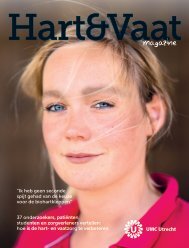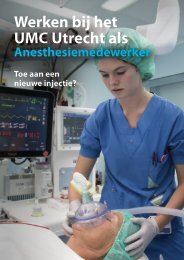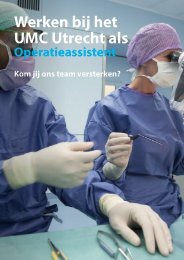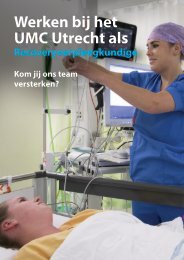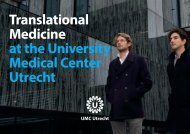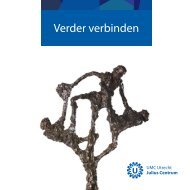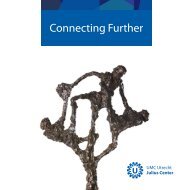Circulatory Health magazine
You also want an ePaper? Increase the reach of your titles
YUMPU automatically turns print PDFs into web optimized ePapers that Google loves.
"This is the<br />
healthcare of<br />
the future”<br />
Nurse practitioner:<br />
for the best care as<br />
well as service<br />
“My colleagues and<br />
I are the linking pin<br />
in patient logistics"<br />
Pieter Doevendans Linda van Tellingen & Esther de Haan Suzanne Elstgeest-Grootenboer<br />
"We're here for the patients," says<br />
Pieter Doevendans, Professor of<br />
cardiology and responsible for<br />
care within the strategic theme.<br />
"In addition to providing the best<br />
possible care, it's the experiences<br />
of our patients that counts. They<br />
must be seen by different<br />
specialties and disciplines within<br />
a few hours and have to feel<br />
comfortable with that.<br />
A pleasant patient experience and<br />
improving the quality of care,<br />
these are the main goals of the<br />
cardiovascular outpatient clinic,<br />
says Pieter. "We work with<br />
different specialists, such as<br />
internal medicine, vascular<br />
surgery, neurology and cardiology.<br />
It is essential that we use uniform<br />
guidelines, which can differ<br />
significantly for the individual<br />
specialties. But with the outpatient<br />
clinic that's a thing of the past,<br />
which also benefits science.<br />
Providing this much care within<br />
such a short period of time hinges<br />
on the logistics. Logistics must be<br />
perfect, so that we can effectively<br />
collect all data and draw up a<br />
treatment proposal together. In<br />
addition, patients must be<br />
included more in science, for<br />
instance so that their DNA can be<br />
used for other genetic<br />
cardiovascular research. The times<br />
that a patient would go from<br />
consulting room to consulting<br />
room and specialists would<br />
determine what happens, are over.<br />
In the multidisciplinary outpatient<br />
clinic, focus is on the patient: this<br />
is the healthcare of the future.”<br />
Even though patients in the<br />
outpatient Center for <strong>Circulatory</strong><br />
<strong>Health</strong> see several healthcare<br />
professionals, they always have a<br />
nurse practitioner as permanent<br />
contact. "We know everything<br />
about every individual patient,"<br />
says Linda van Tellingen.<br />
"They come to us first with their<br />
questions about care and<br />
treatment."<br />
"We conduct the necessary<br />
preliminary work before a patient<br />
visits the specialist," explains Linda.<br />
"I update the medical history." Has<br />
the patient been hospitalized<br />
before, and for what? I review lab<br />
results and identify risk factors. Is<br />
the patient overweight, do they<br />
have a high blood pressure, do<br />
they smoke? To sum up, we focus<br />
on risk management. Because all<br />
patients who enter these doors<br />
have one thing in common: they<br />
are either already suffering from or<br />
run a high risk of cardiovascular<br />
disease. In addition to curative<br />
treatment, we also pay a lot of<br />
attention to prevention."<br />
Nurse practitioners also monitor<br />
cross-disciplinary cooperation.<br />
Linda: "When I notice during triage<br />
that we need a cardiologist in<br />
addition to the vascular surgeon,<br />
I see to it that the cardiologist is<br />
available the same morning. It's<br />
key that patients here receive the<br />
best care as well as service."<br />
From aneurysms and heart failure<br />
to vascular claudication: the<br />
outpatient Center for <strong>Circulatory</strong><br />
<strong>Health</strong> sees different patient<br />
groups for a combination of<br />
specialties. The team of medical<br />
assistants ensures that patient<br />
logistics run like a well-oiled<br />
machine. "Patients must be able<br />
to have all necessary<br />
examinations and interviews<br />
within half a day, like an express<br />
train," says medical assistant<br />
Suzanne Elstgeest-Grootenbroer.<br />
"The process starts with<br />
registration of the patient by the<br />
family doctor," Suzanne explains.<br />
"Or by a specialist in our or an<br />
external hospital.<br />
The referral is assessed by the<br />
attending physician. They<br />
determine which examinations and<br />
appointments with other<br />
specialties are necessary. My<br />
colleagues and I are the linking pin<br />
in the process of a patient's visit to<br />
the clinic. Teamwork is vital for<br />
this. We receive the patient and<br />
answer any questions they may<br />
have. But we also measure blood<br />
pressure, if necessary, and the<br />
pressure in the ankle and arm, the<br />
so-called ankle-brachial index, in<br />
preparation for the consultation<br />
with the doctor. We also arrange<br />
everything concerning wound<br />
care, from A to Z. And after the<br />
consultation, we conclude the visit<br />
to the clinic and schedule a<br />
follow-up appointment. All in all,<br />
the medical assistants are involved<br />
in the entire outpatient process.”<br />
<strong>Circulatory</strong> <strong>Health</strong> Magazine 41









